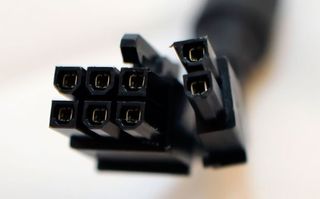How to Pick the Right Power Supply
Count Your Connections!
Of course, power isn’t everything. In addition to how much power you need, you also should count your connectors. I’ve gotten myself into trouble in the past when I discovered that my PSU only has four SATA drive connectors, while I have five SATA devices in my system. Sure, I can use an Molex-to-SATA adapter, but I’d really prefer to have the correct connectors.
So be sure to do an inventory of all the connectors in your system. Don’t forget to take into account possible future growth, particularly with SATA and PCI Express connectors. Better to have four 8-pin PCIe connectors, and use them only in 6-pin mode, than to not have them and discover that new high performance graphics card you just bought requires two 8-pin connectors. Similarly, ensure the PSU has a minimum two extra SATA connectors beyond your existing installation.

Note that some power supplies come with multiple ATX12V connectors – those connectors used to deliver additional dedicated power to the CPU. Some lower end motherboards only have a single 4-pin ATX12V connector, while higher end boards have an 8-pin connector. A few extended ATX boards for workstation and server apps may have an additional 4- or 8-pin connector. Most PSUs have a split 8-pin, in which either 4-pin half may be used in a motherboard with only a 4-pin connector, or may be combined to supply 8-pin ATX12V. A few PSUs ship with dedicated 4- and 8-pin connectors, so you use whichever one you need.

Note that most power supplies still ship with a number of those old Molex 4-pin connectors. These days, those are mostly used for driving fans that don’t connect to a motherboard, though a few older optical drives still exist that use them. On higher end systems, I find those Molex plugs going completely unused, because the case fans are either plugged into the motherboard and controlled by the BIOS or plugged into a dedicated fan controller.
Efficiency & Noise
Now that actual power supply efficiency certifications exist, it’s a little easier to choose a PSU based on a desired efficiency goal.
Before jumping into a discussion of PSU efficiency ratings, let’s discuss a key point. Let’s say you have a system that runs at 70W idle with a 500W PSU. If you drop in a 800W PSU that’s equally efficient, your system will still run at 70W while idling. The system consumes no more power at idle just because you have a PSU with a bigger maximum capacity, assuming both are equally efficient. The bigger PSU gives you more headroom – it will run more quietly and generate less heat when it’s drawing 500W. So having a little extra capacity headroom may reduce noise levels and even generate less heat.
PSU efficiency is rated at five levels for typical desktop PC PSUs; those levels correspond to how well the PSU maintains 80% efficiency over its load range. (There’s actually a sixth level for high voltage redundant PSUs.) Here’s a chart from the Wikipedia article on the 80 Plus standard :
The biggest gaming news, reviews and hardware deals
Keep up to date with the most important stories and the best deals, as picked by the PC Gamer team.
The key takeaway is that higher 80 Plus levels are more efficient. Note that not all power supplies are equally adept at hitting the standards; there are always little variations among different samples. But in general, higher 80 Plus ratings means your PSU is more efficient – and also likely more expensive.
Physical Size
So you’ve just bought that lovely 950W, 80-plus gold certified power supply. It’s heavy and solid feeling, and has all the connectors you ever would want. So you go to install it in your PC chassis, only to find out that you can’t have your hard drives and the power supply installed at the same time.
Oops.
This scenario has happened to me on occasion. PSUs actually come in different physical sizes. The size doesn’t matter much if you pop it into a gigantic, full tower case. But a number of mid-tower cases have constrained PSU spaces that are opposite the optical or hard drive bays. Buy a PSU that’s just a little too long, and you’ll find yourself unable to attach SATA drive connectors.

Bottom line: be sure to check exactly how much space you have, and the physical size of the power supply, before dropping hard coin on that new PSU.
Final Thoughts
We’ve barely touched on the technology underlying today’s power supplies, which deliver more power and are more efficient than ever. However, this should arm you with enough information to make good choices. Remember, if there’s one thing you don’t want to skimp on, it’s the quality of the power supply. If you’re on a budget, be willing to sacrifice a speed grade on your CPU for a better PSU. It’s much better to be stable and actually run your games than have a systems that can generate blue screens of death just a little faster.
Most Popular




